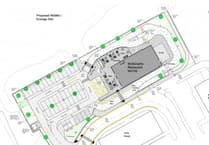CONTROVERSIAL plans for continued clay excavation and the creation of a new access road at Selborne brickworks were on course for approval this week.
Plans submitted by Forestry International Exports were due to be decided by Hampshire County Council's regulatory committee on Wednesday, with chief planning officer Peter Chadwick recommending that they be given the stamp of approval.
This is despite massive local opposition and letters from some 100 residents pleading with the council to scupper the application.
In his report to the committee, Mr Chadwick outlined the proposals and the site's planning history.
It said: "Planning permission is sought for the continuation of clay extraction at Selborne clay pit for use at the adjoining brick and tile works, and also exportation of clay for engineering purposes, followed by restoration to agriculture and nature conservation using imported inert waste for infill.
"The duration of the proposed clay extraction and restoration would be about 38 years.
"The application for an extension of the clay pit was originally submitted in February 2002. The county council responded that an Environmental Statement was required under the Environmental Impact Assessment Regulations 1999.
"The Environmental Assessment was submitted in February 2003, together with an application for an additional area for extraction. The two applications are dealt with as a single proposal.
"Following concerns about the access to the site via Latchford Lane/Roman Road, a further application was submitted in August, 2003, for an access road across Chapel Farm.
"In addition to clay extraction, and infilling with construction and demolition waste with restoration to agriculture, planning permission was granted last year for construction- waste recycling.
"The applicant proposes to extract about 856,500 cubic metres of clay, of which about 110,000 cubic metres would be from deepening the existing clay pit.
"The restoration would require the importation of about 1.1 million cubic metres of inert waste. The duration of the clay extraction would be about 36 years, with restoration being completed within two years of cessation of clay extraction. Access to the site would be via a new access road across Chapel Farm. The proposal would be to use the routing to the A325 at Bordon via Oakhanger Road.
"The proposals would generate a maximum of about 250 heavy goods vehicles movements per day (125 vehicles in, 125 vehicles out)."
Committee members were due to hear that objections to the plan had been voiced by East Hampshire District Council and Selborne Parish Council, which both argue that the plans would spoil the nearby landscape, and fear the effects of the lorry movements using the new access road.
The Oakhanger Preservation Society has said that while it "fully supports" the brickworks, the "clay pit should be for the brick and tile making only. It is not a clay export business and a long-term recycling and inert waste dump".
On top of this, 98 letters of objection have been sent to the county council from local residents urging councillors to throw out the plans on grounds of highway danger and damage to local lanes by the additional lorry traffic.
Despite these concerns, Mr Chadwick said the plans could be approved, which include provisos to allay local fears.
His report said: "The objections to the proposals on the basis of the adverse landscape impact are noted. However, the site is not visible from a wide area and the proposals include additional landscape screening.
"Therefore, provided the working and restoration is progressive it should not be visually intrusive.
"The main concerns that have arisen from the existing operations, and the principal objections to the current proposals, are the impacts of the lorry traffic associated with the site."
But the officer points out that the provision of the new access road would solve many of existing problems.
He also points out that conditions can restrict the use of the clay extracted - limiting the impact of the local area.
"The export of clay from the site is contrary to policy, and exacerbates the need for infill to restore the site. Notwithstanding the improved access route, it is considered that the environmental impact of the traffic should be minimised and so not to allow exportation of clay.
"It is accepted that if the Selborne Brickworks are to be commercially viable, there is the need for suitable clay reserve to justify any continued investment. The existing reserves are insufficient.
"However, it is considered that clay extraction should cease if the Brickworks cease to operate.
"The current proposals would secure the long-term clay supplies to support the Brickworks; however, there are concerns at the proposed export of clay, which is contrary to policy and extent of infilling to achieve restoration.
"In view of the sensitive location - most of the extension is within the proposed National Park - it is considered that the clay extraction should only be to supply the brickworks and there should be no export."



